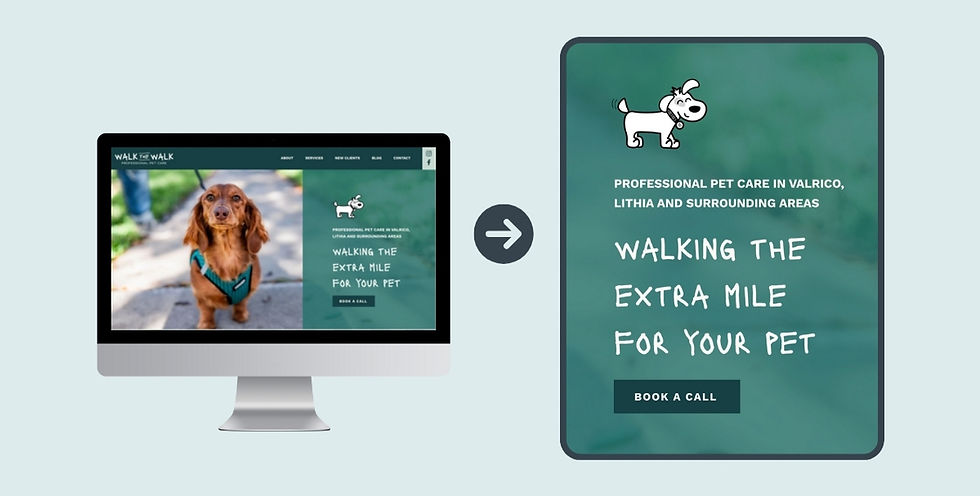Is Your Pet Business Website Guilty of These 5 Mistakes?
- ekrorkx
- Sep 2
- 7 min read
If your pet sitter website, dog walker website, or dog trainer website has been live for a while but you’re not booking as many new clients or getting the leads you’d like, your site might be guilty of some common mistakes.
The good news? These issues are incredibly fixable once you know what to look for. Since 2017, Pet Marketing Unleashed has reviewed hundreds of pet business websites, and we’ve noticed the same patterns pop up again and again. Even small mistakes on your website can mean the difference between getting a new client or losing them to a competitor.
Your website should do the heavy lifting for you. That means:
Clearly showing what you do, for whom, and where.
Making the next step obvious.
Loading quickly so visitors stick around.
Building trust through visuals and testimonials.
Guiding people with simple, clean navigation.
If it’s not doing these things, it’s time for a self-audit. Let’s break down the five biggest website mistakes we see on pet business websites, and how you can fix them.
Subscribe & download the episode to your device: Apple Podcasts | Spotify | YouTube
Mistake 1: Pet Business Websites Without Clear Services, Location, or Niche in the Homepage Banner
Why Clarity is Essential for Pet Parents
Here’s a quick test: If someone lands on your homepage, can they instantly answer these three questions?
What do you do?
Who do you do it for?
Where do you do it?
If not, your site is missing one of the most basic but important elements: clarity. Too many websites make visitors scroll endlessly, guess, or search through multiple pages just to figure out if they’re in the right place. And in the online world, guessing means bouncing.
Think about how many pet websites say something vague like “Professional Pet Care” or “Quality Care for Pets.” Nice words, but do they tell me if you offer dog walking, training, or pet sitting? Do they tell me if you’re even in my area? Nope.

Too many sites make visitors guess, scroll, and comb through pages just to figure out if you’re in their area or even offer the service they need. And in the online world, guessing means bouncing.
❌ Example: “Providing quality pet care” or “welcome to our site” or “business name” sounds nice, but it doesn’t say what you actually offer or where you’re located.
How to Fix a Vague Homepage Banner
✅ Update your homepage header and subheader to include:
Service (dog walking, pet sitting, pet training, etc.)
Location (your city or service area)
Specialty/niche (small dogs, midday walks, separation anxiety, etc.)
If you specialize in something like small dogs, midday walks, or separation-anxiety pups, call that out too. And always, always, always include your service area in that main header banner.
Mistake 2: Weak or Missing Calls-to-Action (CTAs) on Pet Care and Dog Trainer Websites
Why CTAs Matter for Pet Business Websites
You can’t assume people know the next step. Just listing your phone number and hoping for the best isn’t enough. Your website should act like a guide, showing visitors exactly what to do next. Without clear CTAs, pet parents can get lost and leave without booking.
If your “Book Now” button is buried in your footer or only lives on your contact page, people will get lost and leave.
Your website should guide them on a journey - from homepage to services to booking. And that journey is powered by your CTAs.
Common CTA Mistakes on Dog Walker or Pet Sitter Websites
Only having a button on the contact page
Burying the CTA in the footer
Using vague buttons like “Learn More”
How to Improve Your Website CTAs
Every page should guide visitors to their next step with clear, bold, and action-oriented CTAs:
Place a CTA above the fold (before scrolling), midway down the page, and at the very bottom of the page as the final call-to-action.
Use bold, clear and easy-to-see buttons, not just links hidden in text.
Be specific about the action and outcome.
Instead of vague buttons like “Learn More” or “Click Here”, use CTAs that tell people exactly what’s next. Here are some examples:
“Book Your Meet & Greet”
“Create My Account”
“Schedule My Dog Walk”

And make sure the CTA leads where they expect. If someone clicks “Book Now,” don’t send them to a services page. Send them to your booking form or new client intake page. Your website flow should feel natural: after someone finishes a page, the next CTA shows them exactly where to go next.
Mistake 3: Slow Pet Business Websites That Drive Visitors Away
Why Website Speed Matters for SEO and Conversions
Site speed is one of the most overlooked (but most important) parts of a website. Online visitors are impatient. If your site takes more than 2–3 seconds to load, people will click away before they even see what you offer. Not only that, but Google factors site speed into your SEO rankings (hello search results!).
Common culprits for slow loading pet business websites:
Large, uncompressed images: Uploading photos straight from your phone or camera without resizing them first.
Too many apps or plugins: Especially on platforms like WordPress, expired or unused plugins weigh your site down.
Auto-play videos or sliders: They look fancy but eat up speed.
Animations everywhere: Fun to look at, but they can cause slow loading and can frustrate users.
Fixes to improve pet business website speed:
Compress your images before uploading (our favorite free tool we use all the time is Compressor.io, but there’s also TinyPNG, or Squoosh)
Delete expired or unused plugins/apps
Embed longer videos using a third party platform like YouTube or Vimeo instead of uploading directly to your site files
Limit website animations to only those that truly enhance the user-experience
Improving your site speed doesn’t just help user experience. It’s also a ranking factor for Google in the search rankings. The faster your site loads, the more likely it is to show up when pet parents are searching for services like yours.
👉 If SEO feels overwhelming or you’re not sure where to start, our SEO Unleashed Course for Pet Businesses breaks it all down step by step. You’ll learn how to optimize your site speed, set up your on-page SEO, and make sure your website is showing up when local pet parents are searching for dog walkers, sitters, or trainers in your area. Check out the SEO Course to learn more.
Mistake 4: Missing Trust-Building Elements on Pet Care and Dog Trainer Websites
Why Trust Matters for Pet Business Websites
Pet parents aren’t just buying a service—they’re trusting you with their furry family member. Your website needs to make that trust easy to establish.
Would you hire a dog walker or pet sitter without knowing what they look like, what experience they have, or whether others recommend them? Probably not.
Your website needs to prove you’re trustworthy, credible, and experienced. And that goes beyond just saying “bonded and insured” in your copy.
Trust Elements that Boost Bookings
Testimonials & reviews: Not hidden on a separate page, but placed strategically throughout your site.
Certifications & memberships: Pet CPR, insured/bonded, PSI, NAPPS, etc.
Photos of you and your team: Real photos, not just stock images. (This is especially the case for the about page, with you looking into the camera, friend!!)
Case studies or client stories: Transformation stories that show results.
Pro Tips for Building Website Trust
Integrate testimonials into service pages. Example: Place a dog walking testimonial on your dog walking page, not on a never to be clicked on testimonials page. More on testimonial best practices on our blog.
Show your face. A professional photo of you looking into the camera builds subconscious trust. Include photos of you and/or your team actually providing services when possible.
Mistake 5: Confusing Pet Business Website Navigation
Why Simple Navigation Helps Pet Parents Book Faster
If clients can’t find what they need in 1–2 clicks, they’ll leave and book with someone else.
Common Navigation Mistakes:
Overstuffed menus with too many items
Creative but confusing page names
Wasting menu space on “Testimonials” or “Gallery” pages (please don’t have these on your site!!)
How to Create Clean, Easy-to-Use Navigation For Your Website
Keep your main website menu to 5-6 items max:
Home
About
Services (with dropdowns for specific offers)
FAQs or New Client Info
Contact
Use clear, expected labels: About (vs. Meet us), Dog Walking (vs. Dog Adventures), Blog (vs. Notes)
A clean menu doesn’t just help clients. It also helps Google understand your site structure and improve your SEO. People come to a website not to expend brain calories. They want to know exactly where each page leads and they have an expectation of what pages they will see in the menu. It’s our job as business owners to have that on our menu for a clear user experience.
A Recap of The Quick Fixes to Improve Your Pet Business Website
Let’s recap the five big mistakes we see on pet industry websites:
Unclear homepage headlines. Fix with “what, who, where.”
Weak CTA. Place bold, action-focused buttons on every page.
Slow site speed. Compress images, embed videos, clean up apps.
Missing trust-builders. Add testimonials, certifications, and your face.
Messy navigation. Limit menus to essentials with clear labels.
These fixes are quick wins you can implement today, and even small updates can improve your inquiries.
👉 Want to go deeper? We also put together a free guide on 9 Common Website Design Mistakes Pet Businesses Make (plus how to fix them). It’s a great companion to this blog and gives you even more practical ideas to improve your site. Grab the free guide.
But if you’d rather skip the trial-and-error and start with a site that’s already built to avoid these mistakes, check out our pet business website templates. They’re fully customizable, SEO-friendly Wix templates designed specifically for local pet business owners. They even come with an accompanying course that walks you through every step from onboarding strategy and copywriting to SEO and booking integrations.
Your website should be your hardest-working team member. Because, it’s working for you 24/7. It’s just a matter of whether the website is working FOR you or if it’s sending people to your competitor. Start with one fix this week and notice how it impacts your inquiries. Over time, these improvements compound into a site that brings you more of the clients you love.
You’ve got this, petpreneur! And if you’re ready for the shortcut, explore our SEO-friendly pet business website templates for dog walkers, pet sitters, and trainers..









